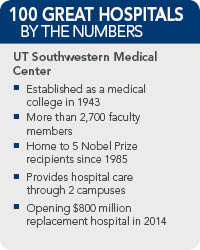UT Southwestern Medical Center (Dallas). The history of UT Southwestern Medical Center began in 1939, when Dallas clinical leaders and citizens organized the Southwestern Medical Foundation to promote medical education in the Dallas area. The Southwestern Medical College officially formed as the 68th medical school in 1943, and the academic medical center has grown exponentially since then.
 At the heart of UT Southwestern are two campuses, Zale Lipshy and St. Paul. Zale Lipshy houses UT Southwestern's award-winning neurological treatment centers, as well as urology, ophthalmology and rehabilitation programs. St. Paul's campus includes cardiology, emergency medicine, internal medicine, OB/GYN, orthopedics and several other essential specialties. However, in late 2014, the $800 million William P. Clements Jr. University hospital will replace the St. Paul facility. U.S. News & World Report ranked UT Southwestern as one of the country's top 50 hospitals for geriatics, gynecology, neurology/neurosurgery and urology for 2013-14.
At the heart of UT Southwestern are two campuses, Zale Lipshy and St. Paul. Zale Lipshy houses UT Southwestern's award-winning neurological treatment centers, as well as urology, ophthalmology and rehabilitation programs. St. Paul's campus includes cardiology, emergency medicine, internal medicine, OB/GYN, orthopedics and several other essential specialties. However, in late 2014, the $800 million William P. Clements Jr. University hospital will replace the St. Paul facility. U.S. News & World Report ranked UT Southwestern as one of the country's top 50 hospitals for geriatics, gynecology, neurology/neurosurgery and urology for 2013-14.
UT Southwestern has one of the most renowned faculties of physicians, scientists and researchers in the South. Since 1985, five UT Southwestern faculty members have received Nobel Prizes, including Michael Brown, MD, and Joseph Goldstein, MD, who won it in 1985 for their discovery of the basic mechanism of cholesterol metabolism. UT Southwestern also has 19 members of the National Academy of Sciences and 18 members of the Institute of Medicine.

 |
 |


